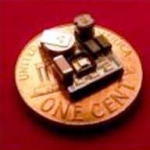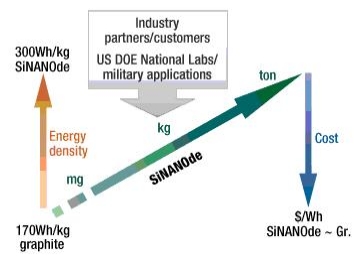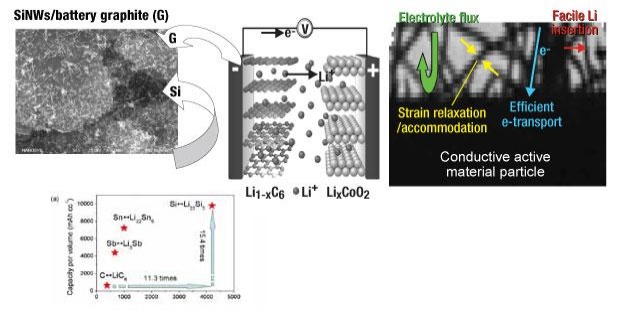July 1, 2011 — In 2011, researchers from MIT, U Penn, and Northern Illinois University have published promising results on manufacturing graphene, a nanomaterial that could offer new electrical and thermal properties to electronic devices. These vastly improve upon the original method of pulling graphene off a block of highly purified graphite with tape.
Massachusetts Institute of Technology (MIT) scientists are producing graphene in significant quantities in a two- or three-layer form, arranged to give graphene a band gap (which it lacks in 1-layer form). The MIT technique yields A-B stacked layers, with the atoms in one layer centered over the spaces between atoms in the next.
Researchers introduced bromine or chlorine compounds into graphite blocks. These compounds insert themselves naturally between every other or every third layer, pushing the layers apart. When the MIT team dissolved the graphite, it naturally came apart where the added atoms sat, forming graphene flakes two or three layers thick. The dispersion process is gentle, which graphene requires.
The basis for MIT’s process was developed in the 1950s by MIT Institute Professor Mildred Dresselhaus, among others.
 |
| Figure. When compounds of bromine or chlorine (represented in blue) are introduced into a block of graphite (shown in green), the atoms find their way into the structure in between every third sheet, thus increasing the spacing between those sheets and making it easier to split them apart. Image courtesy of Chih-Jen Shih/Christine Daniloff |
The method can be scaled to meet the needs of practical graphene applications, said Michael Strano, the Charles and Hilda Roddey Associate Professor of Chemical Engineering at MIT. Due to the gentle processing, graphene flakes were manufacturer as large as 50µm2. The researchers used them to manufacture some simple transistors, validating the production method for use in IC manufacturing.
A similar solvent-based method for making single-layer graphene is already being used to manufacture some flat-screen television sets, report MIT’s team.
The MIT work is described in the journal Nature Nanotechnology, co-authored by graduate student Chih-Jen Shih, Professor of Chemical Engineering Daniel Blankschtein, Strano and 10 other students and postdocs.
The work was supported by grants from the U.S. Office of Naval Research through a multi-university initiative that includes Harvard University and Boston University along with MIT, as well as from the Dupont/MIT Alliance, a David H. Koch fellowship, and the Army Research Office through the Institute for Soldier Nanotechnologies at MIT.
Courtesy of David Chandler, MIT News Office
Northern Illinois University (NIU) researchers fabbed few-layer-thick graphene by converting carbon dioxide into >10atom-thick graphene. The method involves burning pure magnesium metal in dry ice.
Burning magnesium metal in carbon dioxide produces carbon, but the graphene structure produced has "neither been identified nor proven" before, said Narayan Hosmane, a professor of chemistry and biochemistry who leads the NIU research group. He expects the synthetic process to be able to produce few-layer graphene in large quantities, adding that the production process is simple, environmentally friendly, and cost-effective.
Hosmane’s research group was looking to produce single-wall carbon nanotubes (SWCNT), a different nanomaterial. "Instead, we isolated few-layer graphene," he said. "It surprised us all."
Other members of the research group include NIU post-doctoral research associate in chemistry and biochemistry Amartya Chakrabarti, former NIU physics postdoctoral research associate Jun Lu, NIU undergraduate student Jennifer Skrabutenas, NIU Chemistry and Biochemistry Professor Tao Xu, NIU Physics Professor Zhili Xiao and John A. Maguire, a chemistry professor at Southern Methodist University.
The research is described in a June communication to the Journal of Materials Chemistry.
The University of Pennsylvania (U Penn) has demonstrated a consistent and cost-effective method for making graphene that is 1atom-thick over 95% of its area, using readily available materials and manufacturing processes that can be scaled up to industrial levels.
Instead of using chemical vapor deposition (CVD) in a near vacuum, U Penn’s team worked at atmospheric pressure: electropolishing a copper substrate and depositing the graphene onto it. The Penn team’s research shows that single-layer-thick graphene can be reliably produced at normal pressures if the metal sheets are smooth enough. Principal investigator A.T. Charlie Johnson, professor of physics, and his group used commercially available copper foil in their experiment.
"The fact that this is done at atmospheric pressure makes it possible to produce graphene at a lower cost and in a more flexible way," Luo, the study’s lead author, said.
Working with commercially available materials and chemical processes that are already widely used in manufacturing could lower the bar for commercial applications. "The overall production system is simpler, less expensive, and more flexible," Zhengtang Luo, lead researcher, said.
Other team members on the project included postdoctoral fellow Brett Goldsmith, graduate students Ye Lu and Luke Somers and undergraduate students Daniel Singer and Matthew Berck, all of Penn’s Department of Physics and Astronomy in the School of Arts and Sciences.
This study was published in the journal Chemistry of Materials.
The research was supported by Penn’s Nano/Bio Interface Center through the National Science Foundation. Learn more at www.upenn.edu
Graphene is a chicken-wire-like lattice of carbon atoms arranged in thin sheets a single atomic layer thick. Its unique physical properties could lead to major advances in solar power, energy storage, computer memory and a host of other technologies.
Complicated manufacturing processes and often-unpredictable results currently hamper graphene’s widespread adoption. Learn more about nanomaterials production capacities in CNT, graphene, other nanocarbon production lags capacity for now
Subscribe to our MEMS Direct newsletter






 Listen to Zhu’s interview:
Listen to Zhu’s interview: